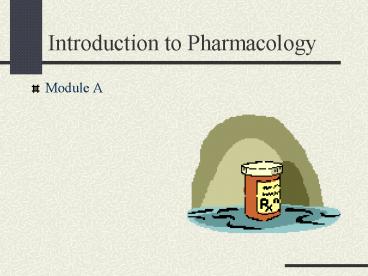Introduction to Pharmacology - PowerPoint PPT Presentation
1 / 29
Title:
Introduction to Pharmacology
Description:
Introduction to Pharmacology Module A Common Pharmacology Terms Pharmaceutics Pharmacodynamics Pharmacogenetics Pharmacognosy Pharmacokinetics Pharmacology ... – PowerPoint PPT presentation
Number of Views:288
Avg rating:3.0/5.0
Title: Introduction to Pharmacology
1
Introduction to Pharmacology
- Module A
2
Common Pharmacology Terms
- Pharmaceutics
- Pharmacodynamics
- Pharmacogenetics
- Pharmacognosy
- Pharmacokinetics
- Pharmacology
- Pharmacotherapeutics
- Other terms are
- independent study
3
History of Pharmacology
4
History of Pharmacology
- Mystical Period
- Empirical Period
- Medieval Period
- Contemporary Period
5
Sources of Drugs
- Plants
- Animals and Humans
- Minerals and Mineral products
- Synthetic or Chemical substances
6
Sources of Drugs and Drug Information
- Physicians Desk Reference (PDR)
- Package Inserts
- Nursing Drug Guides /Nursing Journals
- Internet websites
7
Legal and Ethical Issues
- Legal Issues
- Ethical Issues
- Basic Ethical Principles
- Beneficence
- Nonmaleficence
- Autonomy
- Justice
- Veracity
- Confidentiality
8
Legal and Ethical Issues
- Nurse Practice Act- describe and define the legal
boundaries of nursing practice within each state.
9
Legal and Ethical Issues
- Students role in medication administration
- Held to the same standards as licensed nurses
- Responsible for their own actions
- Important to know the Nurse Practice Act
10
Federal laws
- Food and Drug Administration
- Pure Food and Drug Act of 1906
- Federal Food, Drug and Cosmetic Act of 1938
- 1952 Durham-Humphrey Amendment of the 1938 Act
- 1962 Kefauver-Harris Amendment of the 1938 Act
11
Federal laws, cont
- 1970 Comprehensive Drug Abuse Prevention and
Control Act - Harrison Narcotic Act
12
State laws
- Conforms to the federal legislative guidelines
- Additional control, such as with substances not
regulated by the federal government
13
FDA approval process
- Investigational New Drug Application
- Informed Consent
- U.S. Food and Drug Administration Drug Approval
Process - Preclinical Investigational Drug Studies
- Four Clinical Phases of Investigational Drug
Studies - a. Phase I
- b. Phase II
- c. Phase III
- d. Phase I
- Expedited Drug Approval
14
Controlled Substance Act
- The Controlled Substance Act of 1970
- Promoted drug education and research into the
prevention and treatment of drug dependence,
strengthened enforcement authority, established
treatment and rehabilitation facilities, and
designed schedules or categories for controlled
substances.
15
Controlled Substances Schedule Categories
- See the diagram in the textbook
16
Pharmacodynamics
- Pharmacodynamics- The action of a drug on the
body, including receptor interactions, dose
response phenomena, and mechanisms of therapeutic
and toxic action.
17
Receptor theory- MOA
- Receptor is a reactive site on the surface of a
cell or tissue. - Drug forms a chemical bond with the receptor
sites - Drug binds to and interactions occurs at the
receptor site thus producing a pharmacologic
response
18
Receptor theory- MOA
- Agonist
- Partial Agonist
- Antagonist
- Competitive Antagonist
- Noncompetitive Antagonist
19
Nonreceptor drug actions
- Enzyme Interaction
- Nonspecific Interaction
20
Pharmacokinetics
- The actions of the body on the drug, including
absorption, distribution, metabolism, and
elimination or excretion
21
Pharmacokinetics
- Absorption
- Distribution
- Metabolism or Biotransformation
- Excretion or Elimination
- Serum half-life
- Factors that affect pharmacokinetics
22
Absorption
- Process by which a drug is transferred from its
site of entry into the body to the circulating
fluids of the body for distribution.
23
Distribution
- The ways in which drugs are transported by the
bodys circulating fluids to the sites of action,
metabolism, and excretion.
24
Metabolism or Biotransformation
- Process by which the body inactivates the drugs.
- Liver is the most responsible organ.
- Other tissues and organs
- Skeletal muscle
- lungs
- Plasma
- Kidneys
- Intestinal mucosa
25
Excretion or Elimination
- Process of ridding the body of the drug
metabolites and some active drug forms. - Two primary elimination organs
- Kidneys- urine
- GI- feces
26
Serum half-life
- A measure of the time needed for 50 of the drug
to be eliminated from the body.
27
Factors that affect pharmacokinetics
- Age
- Body Weight
- Metabolic Rate
- Illness
- Psychologic Aspects
- Tolerance
28
Pharmacology
- The study of substances that interact with
living systems through chemical processes, e.g.
by binding to regulatory molecules that activate
or inhibit normal body processes.
29
The End
- Questions
- ?????????????????????????????????????????????????
??????????????????????????????????????????????????
??????????????????????????????????????????????????
??????????????????????????

